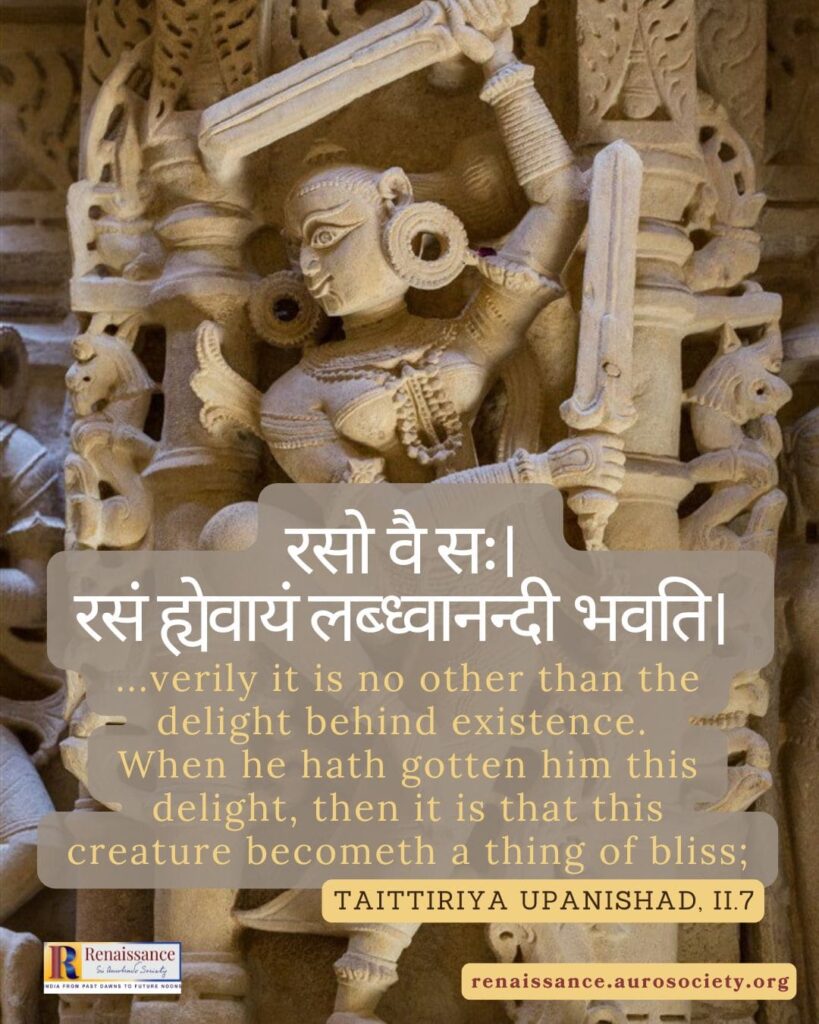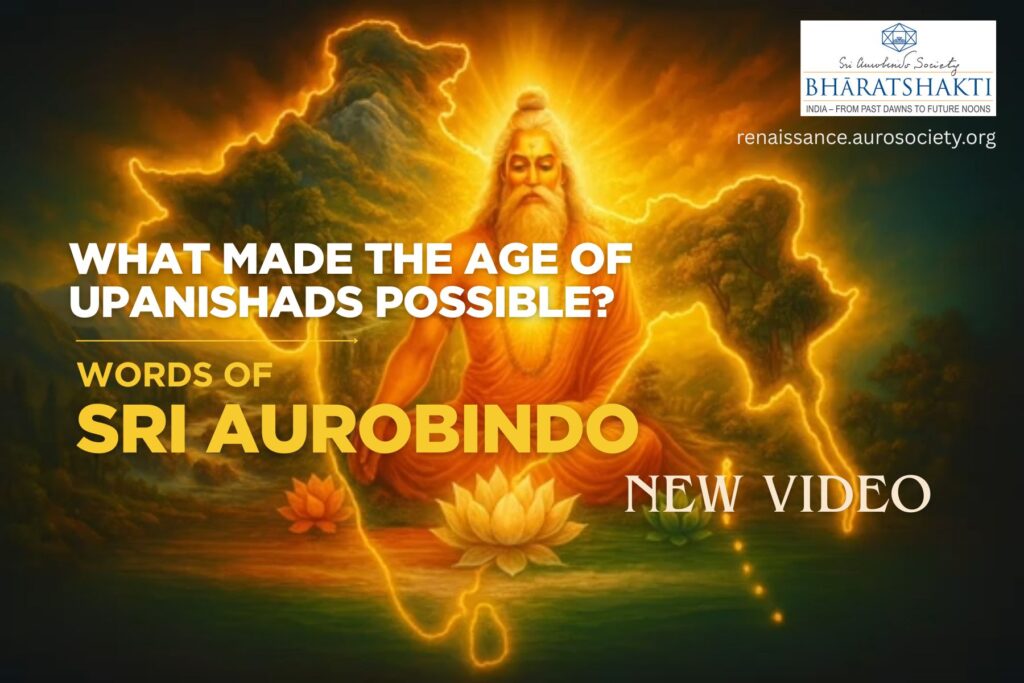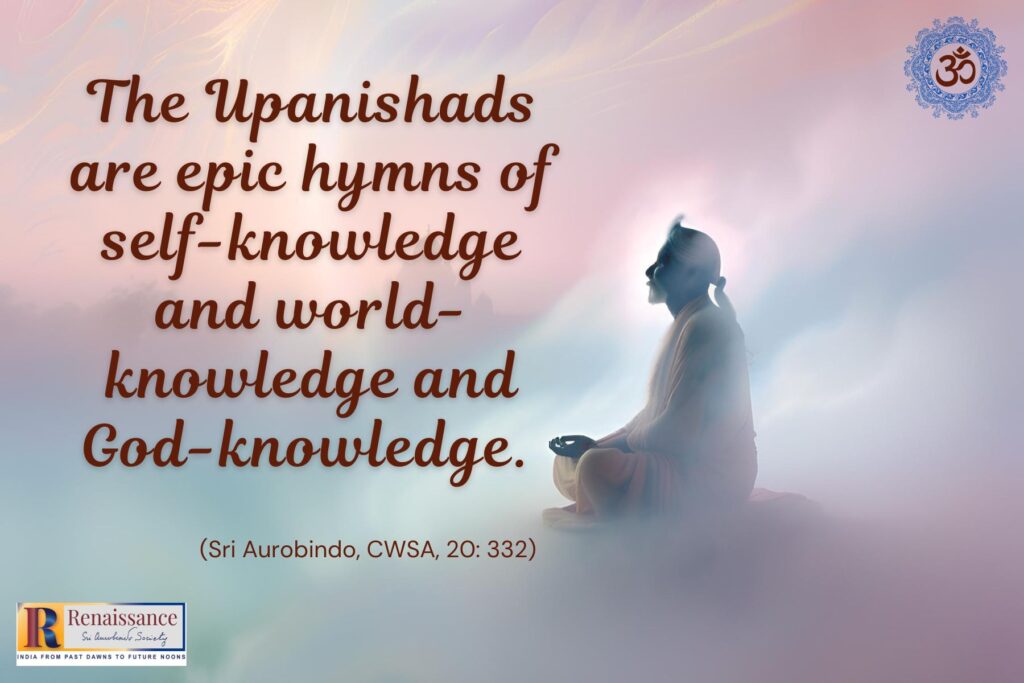Volume V, Issue 9
Author: V.K. Gokak
Editor’s Note: Rasa and Bhāva are two key terms in Indian theories of Aesthetics. Rasa theory blossomed beginning with the Sanskrit text Nātyashāstra, a work attributed to Bharata Muni. Eight rasa-s and associated bhāva-s are named and their enjoyment is likened to savouring a meal: rasa is the enjoyment of flavours that arise from the proper preparation of ingredients and the quality of ingredients.
Eight sthayi bhāva-s and their corresponding rasa-s are:
- Śṛngāram: Rati (Love, Attractiveness)
- Hāsyam: Hasya (Laughter, Mirth, Comedy)
- Raudram: Krodha (Fury,Anger)
- Kāruṇyam: Soka (Compassion, Tragedy)
- Bībhatsam: Jugupsa (Disgust, Aversion)
- Bhayānakam: Bhaya (Horror, Terror)
- Vīram: Utsaha (Heroism, Energy)
- Adbhutam: Vismaya (Wonder, Amazement, Astonishment)
The theory of the rasa developed significantly with the Kashmiri aesthetician Āndandavardhana’s classic work on poetics, Dhvanyāloka which introduces the ninth rasa, shānta-rasa as a specifically religious feeling of peace (śānta) which arises from its bhāva, weariness of the pleasures of the world.
We have selected a few excerpts from a thoroughly researched comprehensive essay by the noted author V.K. Gokak. This was first published in two parts in the annual journal, Sri Aurobindo Circle (1949 and 1950), and presents a fresh statement of the meaning and scope of rasa. The author explains that rasa is a many-throned power and that its imperial sway extends from the consciousness of the poet or artist to that of the rasika or reader, thus relating the various meanings of the word rasa to the entire process of aesthetic experience.
The excerpts will be presented in 3 parts over the next 3 issues, with the first part starting in the current issue. For the purpose of this digital presentation, we have made a few minor formatting revisions.

PART 1
Rasa: The Semantic Approach
Rasa is one of those quintessential words in Sanskrit which sum up a whole philosophy or even a civilization. This article attempts to assess the value of its various aesthetic meanings for a comprehensive theory of rasāsvāda (also written as rasasvada) or aesthetic experience.
The two consonantal elements in the word RASA, R and S, have a meaning of their own in the language of the gods. In his work ‘The Candle of Vision’, AE (George William Russell) speaks of his intuitive perception of the meanings of consonants. According to him, “R” stands for “motion” and “S” for “impregnation, in-breathing, or in-souling at the stage when the one life breaks into myriads of lives.” Thus one can imagine a jet of water springing from the heart of a rock. It is the movement that is perceptible first. The jet then bursts forth into many-coloured spray.
The origin of the word rasa has not been recorded by Monier-Williams in his dictionary.
He mentions the verb (to taste) as a derivation from the noun. He gives another verb, रस्, which means: “to roar; yell; cry; sound; reverberate.” (Meanings found in the Shatapatha Brahmana.) This is referred for its etymology to another verb Raas (रास्) which also means: “to cry aloud; to howl.” It is found in the Mahabharata. It is therefore a later form.
Both are referred to another root, रा, meaning: “to grant; give; yield; surrender,” found in the Rigveda. It may be noted that “R” here conveys the suggestion of movement, for giving or surrendering is a kind of movement. But this account of the origin of रस् leaves the second consonantal element “S” unexplained.
There is another noun in the Rigveda, रसा, a feminine noun, meaning: “moisture; humidity; a mythical stream supposed to flow round the earth.” This also has been given without any account of its origin.
Another verb, सृ, found in the Rigveda, means: “to run; flow; speed; glide; move; go; spring up.” We do not know whether the substantives, रस and रसा, with their meanings of “water; liquid” and “humidity; and moisture” are connected in some way with this root.
Coming to रस itself we believe that the first current meaning of the word was: “water; a liquid.”
It gradually came to connote the sap of plants, the juice of fruit, and consequently the best part of anything or its essence. All these meanings are found in the Rigveda. In Atharvaveda II.26.5 we have the term धान्यं रसं. During the Upanishadic period this meaning, “essence”, is retained: प्राणो वा अङ्गाना रसः (prana is the essence of the limbs; Brihadaranyaka Upanishad, 1.3.19).
The progeny of meanings in this line is numerous. In the Ramayana, रस comes to mean any mixture, elixir or potion. And in the Mahabharata it is used for liquor, drink, melted butter, milk.
In the sense of “taste” or “flavour” as the principal quality of fluids, of which there are six original kinds (madhura, sweet; amla, sour; lavana, salt; katuka, pungent; tikta, bitter; and kashaya, astringent), the word is found in the Shatapatha Brahmana. It will be seen that this is a natural extension of meaning from the essence of an object to its essential flavour.
The word has this meaning “savour”, “taste” in जिह्वया हि रसान्विजानाति (Brihadaranyaka Upanishad III. 2.4).
From this, it is possible to imagine that the word came generally to be applied to the various flavours of food, the षड्रसाः (shadrasas) as in the Shatapatha Brahmana. It is possible that by the time of Bharata, this meaning of rasa was widely current. The next step was a legitimate extension of meaning from the flavours to be tasted with the tongue to the flavours to be tasted by the mental palate.
यथा बहुद्रव्ययुतैर्व्यञ्जनैर्बहुभिर्युतम् ।
आस्वादयन्ति भुञ्जाना भक्तं भक्तविदो जनाः ॥ ३२॥
भावाभिनयसम्बद्धान्स्थायिभावांस्तथा बुधाः ।
आस्वादयन्ति मनसा तस्मान्नाट्यरसाः स्मृताः ॥ ३३॥Just as connoisseur of cooked food (bhakta) while eating food which has been prepared from various spices and other articles taste it, so the learned people taste in their heart (manas) the Durable Psychological States (such as love, sorrow etc.) when they are represented by an expression of the Psychological States with Gestures. Hence these Durable Psychological States in a drama are called Sentiments.
~ Natyashastra, Chapter VI

A development of the subjective meanings of the word along with the objective is seen in the Mahabharata. There rasa means “love; desire; pleasure; delight.” In the Natyashastra, it has another aesthetic connotation – “the taste or character of a work of art or the sentiment prevailing in it.”
But already in the Upanishads the word had been elevated to a transcendental significance which could unite into itself the subjective as well as the objective meanings. There is the famous utterance, रसो वै सः। रसं ह्येवायं लब्ध्वानन्दी भवति। (Taittiriya Upanishad, II.7) where the two meanings of rasa: “essence” and “taste” coexist. Rasa here means the highest essence, the Supreme Reality. It also means the most ennobled taste or experience of delight.
The Supreme Reality manifests itself in the subject as well as the object, in the seer and the seen.
It also transcends them both and lives in its own luminousness. Because it permeates both the subject and the object, it is possible for the subject to apprehend the object. The आवरणभंग or dis-environing or unveiling of the object is nothing other than the elimination of the accidental aspects or in-essentialities of the object, and the apprehension of the reality in its core.
The dis-environing process or आवरणभंग is, in a sense, primarily applicable to the subject. For the right vision can be attained only when the anti-self is replaced by the real self, the divided and limited consciousness by the integral and unlimited awareness. The Supreme Reality is none other than the true self of the individual and the reality in the core of the object. It permeates and transcends them both.
“The Spirit (Atman),” says A. Coomarswamy, “is at once the flavour of all existence and the essence (Sat), truth (Satyam) and beatitude (Ananda) on which all life depends; itself the taster (rasavetri), it tastes only of itself, whether as immanent or transcendent, and the flavour is one and the same and indeterminable no matter what the source or vessel that may have seemed to characterize it.” (Dictionary of World Literature, p. 320)
It is in the same sense that Buddhist rhetoric speaks of Truth as the sweetest of flavours. Rasa, therefore, is Sat or supreme existence, Chit or supreme awareness, and Ananda or supreme delight. The many-coloured game of subject and object, of which this universe is the theatre, is possible only because of the radiance of the Supreme Reality. An inward impulsion or inscrutable purpose makes objects melt at our gaze and yield their meaning to us, because the Reality that permeates both us and them is one and the same.
READ:
“To find highest beauty is to find God”

Rasa: The Transcendental and Immanent Reality
The evolution of the subjective and objective meanings of rasa as “essence” and “taste” and their re-integration into the Supreme Reality (रसो वै सः) has a deep significance for the theories of rasa that followed. The word came to be applied to all the stages in the process of contemplative and creative activity from its emergence in the poet to its consummation in the reader. The following table gives an analysis of all the processes connected with rasa and gives the subjective meanings with their corresponding objective equivalences.
Subjective
- Taste; the artist’s seership or vision.
- The various attitudes projected by the seer towards the object: Rati, Hasa, etc.
- The fugitive emotions of the artist.
- The contemplative and creative delight of the artist.
- The artist’s reconstruction of narrative or dramatic action contained in the theme so as to convey his attitude fittingly, by employing his system of tastes and abilities.
- The reconstruction of the theme so as to accommodate his secondary modes of consciousness.
- The emotions aroused in the artist in the process of creation.
- The producer’s, reciter’s or actor’s apprehension of the significance of a work of art.
- The rasika‘s interior act of tasting flavour un-particularised.
- The rasika’s aesthetic delight arising from an apprehension of art.
Objective
- Essence; the potentiality in the object.
- The specific potentiality in the object arousing a particular attitude (vastu ākāratā).
- The secondary potentialities of the object.
- The theme chosen by the artist for an expression of his essential attitude and delight.
- The form of the work of art, the entire action, the “consequents” or deeds of the character or characters and the characters themselves.
- The expression of these modes in outstanding scenes, episodes, descriptions, character-types and particular beauties of utterance.
- The technical triumphs surmounting the difficulties in the theme.
- The interpretative role of one or all of them.
- Ideal beauty of flavour contained in any element in poetry contributing to our experience of chamatkara.
- The embodiment of that delight in the enriched and heightened culture of the life of humanity.
There is a passage in Abhinavagupta’s work, where Lochana sums up the theories of rasa prevalent in his time. It shows how several meanings of the word recorded above were prevalent at that time.
….तन्नाट्यमेव रसाः । अन्ये तु शुद्धं विभावम्, अपरे तु शुद्धमनुभावम्, केचित्तु स्थायिमात्रम्, इतरे व्यभिचारिणम्, अन्ये तत्संयोगम्, एके अनुकार्यं, केचन सकलमेव समुदायं रसमाहुरित्यलं बहुना॥
….tannāṭyameva rasāḥ । anye tu śuddhaṃ vibhāvam, apare tu śuddhamanubhāvam, kecittu sthāyimātram, itare vyabhicāriṇam, anye tatsaṃyogam , eke anukāryaṃ , kecana sakalameva samudāyaṃ rasamāhurityalaṃ bahunā।
It has thus been maintained that:
- histrionics alone is rasa;
- vibhavas or objects alone are rasa;
- anubhavas or consequents alone are rasa;
- sentiments or permanent moods alone are rasa;
- fugitive emotions alone are rasa;
- integration of permanent moods, fugitive emotions, objects and consequents is rasa;
- characters are rasa; and
- the synthesis of all the foregoing is rasa.
Bhoja also maintains that rasa resides in the poet as well as his plot; in the work of art as well as in the spectator and actor. The seat of rasa has thus been a bone of contention in Sanskrit literary criticism.
TO BE CONTINUED…
~ Design: Beloo Mehra



